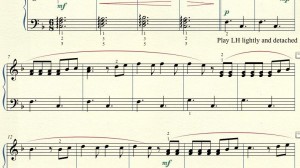Finale 2012: Lessons in Peaceful Coexistance
 1. While there is certainly a need to vent multiple frustrations when working with Finale, there is no need to use foul language. I have begun taking a page from a recent Whad’ya Know broadcast and using Serengeti or (for more emphasis) Serengeti Plain instead. For example: Where in the Serengeti did Finale stash the pedal markings? What in the Serengeti Plain just happened? WSP!? Go to the freaking Serengeti Plain Finale!!!
1. While there is certainly a need to vent multiple frustrations when working with Finale, there is no need to use foul language. I have begun taking a page from a recent Whad’ya Know broadcast and using Serengeti or (for more emphasis) Serengeti Plain instead. For example: Where in the Serengeti did Finale stash the pedal markings? What in the Serengeti Plain just happened? WSP!? Go to the freaking Serengeti Plain Finale!!!
2. When adding finger numbers, using the text function and then copying/pasting really speeds things along. If you do each finger number individually, you have to change the font/size/style for each one. I get the first one set the way I want and then copy it to the clipboard. Then, I can just paste it to each new text box and use highlight/replace.
3. To add markings for rolled chords:
- Click the articulation tool
- Click Create in the selection box
- Click Main
- Type ‘g’
- Click OK
- Click Copy the Main Symbol
- Select Verticality
- Press return twice
- The rolled chord marking is now on top of the chord
- Use the top handle to move the marking over and position it where you want
- Use the bottom handle to stretch the marking to fit the spacing of the chord
You can now use each and every step again for each rolled chord symbol in the piece. No, it doesn’t get faster with repetition. See #1.
4. When the handle to stretch a marking vertically seems to be missing, look for it about a third of the way down the page. WSP!?
5. There is an online Use Manual available which can be very helpful. However, some of the directions there appear to be either incomplete or for previous versions (also there is the problem of knowing the correct magic incantation to type into the search box). Googling what you are looking for will often get you a workable answer faster than using the manual.
6. Always add dynamics, text, fingerings, etc. last rather than putting them in as you go. When you edit your score or adjust the layout these items do not adjust automatically. If you wait until the end of the process to add them, you will avoid the need to essentially add them twice, as well as, the need to consult #1. Articulations, however, do attach to and move with your edits. WSP!?
7. If you are using Finale with a laptop, get yourself a USB NumPad. You will avoid much frustration and possible repetitive motion injuries. I have a chart of substitute keys to use on a laptop but my brain is full and, trust me on this, so is yours.
8. Finale can believe. You may indeed laugh, but it is quite true. In order to group subdivisions logically, you select your actual time signature (say 4/8) and then go in and tell it to believe that it is in 4/4 and beam the 8th notes as such. Now how many hours did somebody spend engineering that? It took my own engineer husband and I four hours to figure it out or maybe it just felt that way…
I’ll stick with MuseScore — at least I can swear for free with that. 🙂
MuseScore is great for opening files from both Finale & Sibelius. I was unable to edit files opened that way though. All programs have issues. You just have to figure out the workarounds. Kinda like Word.
One word: MuseScore!